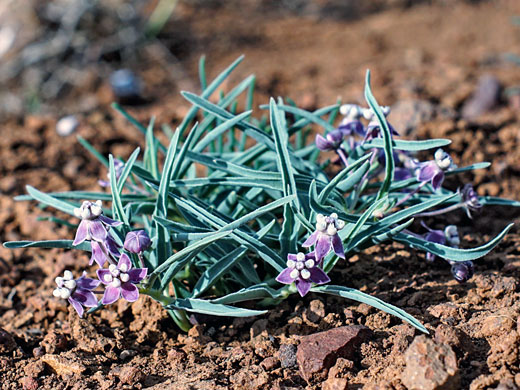Common name:
Wheel milkweed
Family:
Scientific name:
Asclepias uncialis
Main flower color:
Range:
Scattered areas in Arizona, Colorado and New Mexico, and single occurrences in west Oklahoma and west Texas
Height:
Up to 4 inches
Habitat:
Grassland, plains, canyons, washes, juniper woodland; from 3,000 to 6,000 feet
Leaves:
Alternate and opposite, linear to narrowly lanceolate, up to 2 inches long and 0.4 inches across, on short stalks
Season:
March to June
Asclepias uncialis, wheel milkweed, is relatively widespread though never particularly common. The main locations are southeast Arizona, southeast Colorado, extending just into Oklahoma, and scattered sites in New Mexico.
Plants are low growing, just a few inches tall, with multiple stems bearing short, curved hairs, and narrow leaves, often folded up along the middle. Leaf margins are entire, ciliate, while leaf surfaces are sparsely hairy, mainly along the midvein.
Flowers are produced relatively early in the year, starting in March; they are arranged in small clusters (three to seven), at the tip of the stem and the upper leaf nodes. Calyx lobes are purplish, elliptic and reflexed, the corolla lobes ovate, similarly colored, and spreading. The five hoods are rose pink to violet below, white to pale orange above, while the horns are white.
Plants are low growing, just a few inches tall, with multiple stems bearing short, curved hairs, and narrow leaves, often folded up along the middle. Leaf margins are entire, ciliate, while leaf surfaces are sparsely hairy, mainly along the midvein.
Flowers are produced relatively early in the year, starting in March; they are arranged in small clusters (three to seven), at the tip of the stem and the upper leaf nodes. Calyx lobes are purplish, elliptic and reflexed, the corolla lobes ovate, similarly colored, and spreading. The five hoods are rose pink to violet below, white to pale orange above, while the horns are white.
All Contents © Copyright The American Southwest | Comments and Questions | Contribute | Site Map

